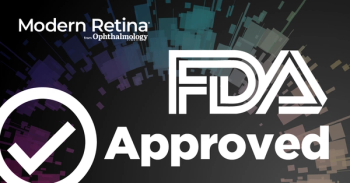
Patricio Schlottmann, MD, highlights 4-year extension data during EURETINA 2025
Patricio Schlottmann, MD, Head of Clinical Research, Charles Centro Oftalmológico, Argentina, caught up with Modern Retina during the 2025
The study, spanning four years through parent and extension studies (YOSEMITE, RHINE, and AVONELLE-X), demonstrates sustained visual gains and treatment durability. With 80% of patients maintaining extended treatment intervals and excellent safety profiles, the research offers promising insights into long-term management of this chronic retinal condition.
Editor's note: This transcript has been lightly edited for clarity.
Patricio Schlottmann, MD: So my name is Patricio Schlottmann. I am a retina specialist from Buenos Aires, Argentina. I practice at the Charles Research Center. It's a site in Buenos Aires where we conduct most of the clinical trials that are ongoing at the moment for new therapies for retinal diseases.
So some of the studies that we have participated in were the development of the faricimab treatment for patients with wet AMD. What we have been presenting here, me and other investigators that were part of the main studies on this treatment for these retinal condition as wet AMD, is that we've seen in the extension studies—the parent studies were called YOSEMITE and RHINE.
These 2 studies lasted for 2 years, and then this led to an extension study that was called AVONELLE-X. So during the AVONELLE-X, we wanted to explore whether the benefits that were achieved in the first 2 years of treatment were maintained and whether the extensions that we achieved with a long-lasting drug like faricimab were maintained over the course of the extra 2 years.
So what we have seen are positive results. We've seen that those visual gains that you get in the first 2 years of the treatment, of the parent study, in the extension study, these benefits are maintained. More and more patients move into a 16-week or 12-week or more treatment; we could say so, extended durability in almost 80% of the patients. That was what was seen in the first part of the study, and this was maintained into the extension study.
Most of the time, what is the importance of these is that many times we see things happening in pivotal studies. For the first 2 years, you get some benefit, but then you don't know what happens in the long term. Macular degeneration is a long-term condition, and it's very important to see what happens in the long term with these patients. So that's why these are very reassuring results. What you see in the first 2 years are well maintained regarding safety and efficacy towards the next 2 years, which is the extension study.
For the extension study, not all patients continued into the study. This was offered to the patients, but the attrition that we achieved, that means how many patients were interested in continuing in this study, was very high. Actually, 80% of the patients did continue into the extension study. So we can say that is very positive. The majority of patients staying and being happy to be continued under the treatment with this drug within a clinical trial. So that's a very positive information.
So the benefit of having long-term data, particularly in studies exploring treatments for patients with wet AMD, is that we know that wet AMD is a chronic condition. Unlike diabetic macular edema, in which you treat the patient and you sort of induce a disease modifying treatment, here patients are for the long-term, receiving the treatment. It's very important to keep them within the treatment.
We have seen in other studies that whatever gains you obtain at the beginning, they tend to wear off over time because of 2 things, atrophy and fibrosis, and sometimes lack of efficacy or loss to follow-up. It's very important because we have managed to get 4 years information, and this is not something we have for lots of other drugs. So for faricimab, we have four year information so we know exactly how the patients ended up, the original study and then the extension study.
The rest, of course, we would like to know what happens after 6, 8, 10, 12 years of follow-up of these patients, and that's going to come from the real-world studies that are being conducted, some of them supported by pharma companies and some others, just groups of physicians collecting data to get more solid real-world data.
I think I would like to reaffirm that the most important part, I mean, we're very happy with the results of efficacy, but the most important thing, particularly with this sort of a new drug, is safety. Everybody's worried these days about safety, what happens when you treat your patients, particularly for long periods of time. What we have seen is that safety was perfect, exactly as expected, exactly as it was described within the original parent study.
So I would, if I have to take one of the, you know, most important messages from the extension study is that safety was very good. Of course, efficacy is important, but safety, it's a cornerstone of making a decision to go for one treatment or another treatment.
Newsletter
Keep your retina practice on the forefront—subscribe for expert analysis and emerging trends in retinal disease management.
















































